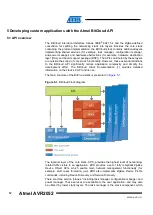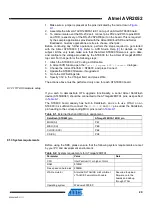
26
Atmel AVR2052
8200M-AVR-11/11
by the image according to the frequency band of the specified region. Possible
options are
US
,
EU
, and
China
. For example, to use JTAG to program a device based
on an RF212 radio with an image of the WSNDemo application for use in the US, use
the file with the name
WSNDemo_Rf212_US.hex
The ready-to-use binary images retrieve MAC address automatically from the UID
chip, ensuring that unique MAC addresses are assigned to all network nodes. Also
note that the default WSNDemo application images are configured to use Extended
PAN ID
0xAAAAAAAAAAAAAAAA
and channel mask with:
•
Channel 0x0F enabled for ZigBit and Atmel ZigBit Amp (WSNDemoApp.hex),
•
Channel 0x00 and channel page 0 (WSNDemoApp_EU.hex) or channel 0x01 and
channel page 0 (WSNDemoApp_RF212US.hex) for Atmel ZigBit 900,
•
Channel 0x01 and channel page 5 (WSNDemoApp_China.hex) for ZigBit 900.
8.4 Running WSNDemo
8.4.1 Starting WSNDemo
To start WSNDemo, proceed as follows:
1. Set up the hardware, as described in Section
2. Install the Atmel BitCloud SDK, as described in Section
3. Program one device with the coordinator image file and other with either the
router or end device images using one of the methods described in Section
4. Connect the coordinator node to the PC using the USB port on the coordinator
board.
5. Power on the coordinator node.
6. Run WSNMonitor (see Section
).
7. Power on and reset the rest of the nodes.
8.4.2 Monitoring WSNDemo activity
Network activity can be monitored in two ways:
•
Observing color LEDs on MeshBean boards (see
•
Monitoring network topology and configuration through WSNMonitor installed on a
PC
Table 8-10.
LED indication for MeshBean boards used in WSNDemo.
Node state
LED1 (red)
LED2 (yellow)
LED3 (green)
Searching for network
Blinking
OFF
OFF
Joined to network
ON
+ receiving data
Blinking
+ sending data to UART
(coordinator only)
Blinking
Sleeping (end device only)
OFF
OFF
OFF
NOTE
When WSNDemo runs on a board other than a MeshBean, special care must be
taken to reconfigure the application to output the networking state to available user
interfaces (for example, LEDs).






























